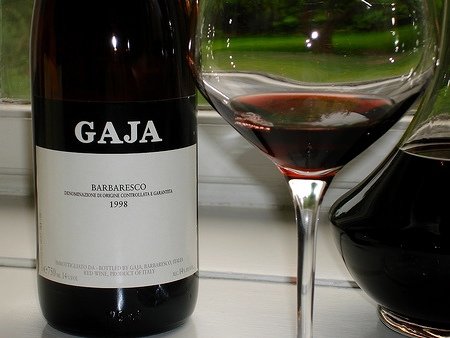The story begins in 1859, when Giovanni Gaja began planting vines in a few hectares (5 acres) of land he owned in Piedmont. He crafted the Nebbiolo into his own Barbaresco (named for his town) and sold it out of his trattoria. As time went on, he became one of the first producers in Piedmont to sell his wine outside the region.
Giovanni passed on his passion for the grape to his son, Angelo, who's wife, Clotilde Rey, helped him focus his winemaking philosophy and was instrumental in organizing vineyard management.
As the vineyard and quality began to grow, it was their son, Giovanni, who continued the fight for the valor of their little Barbaresco. For years, the neighboring town of Barolo was the champion of Piedmont. Labeled, "The King of Wines and the Wine of Kings," anyone who was anyone knew that Nebbiolo was only truly captured by the majesty of Barolo.
Giovanni knew better. He went from merchant to merchant and restaurant to restaurant to prove the unsurpassed quality of his wares. Time and time again he was told that no one wanted a Barbaresco -- everyone wanted to drink only Barolo. Giovanni changed the label, shifting the traditional focus from the word Barbaresco, instead showcasing "Gaja" predominantly on the label. He would not give up, and insisted that his was unlike any other Barbaresco they had ever tasted.
He was right. And what made his wine so much better than all the rest? Underneath it was years of family tradition and an absolutely relentless desire to make the best Nebbiolo from the best vineyards in the best locations possible in the only region in the world to be able to produce such wines.
Giovanni died in 2002, but almost 50 years earlier, he bequeathed control to his son, Angelo, who took the helm and has taken an amazing product and raised it to almost mythical proportions. He employed cutting edge technology for pressing and pruning (8-10 buds per vine instead of 20-24), he was the first person in Piedmont to produce single vineyard Nebbiolo and he was the first to use barrique barrels for aging. In 1979, he spearheaded a movement to have quality control measures enforced on cork producers. He then began planting all his vines vertically rather than the traditional horizontal planting, was the first to plant Cabernet Sauvignon in more than a century, also planted Chardonnay and Sauvignon Blanc in Langhe, and began a worldwide distribution with Gaja Distribuzione.
Not only has he taken the grape Nebbiolo and created some of the finest wines in the world, but he has done so with 100 percent family owned vineyards. The Gaja holdings in the Langhe, Barolo and Barbaresco cover more than 250 acres. And even more than that, he has taken the small town pride and family zeal and transplanted it to two other regions in Italy. The Pieve Santa Restituta in Montalcino, where they make Brunello on 40 acres and the more than 270 acre Ca'Marcanda property in Maremma (Bolgheri), which focuses on international varietals Cabernet, Merlot and Cabernet Franc, Sangiovese and Syrah.
So, after all this historical flattery and antiquated attempt at the "winged word," why am I waxing poetic to this extent?
The wines are just ... that ... good.
I was fortunate enough to be invited by Gaja's New York PR firm to attend a lunch this past Tuesday at Bacchus, A Bartolotta Restaurant. The incomparable daughter of current owner, Angelo Gaja, Gaia Gaja (first and last names are pronounced identically) was present to showcase the family and their wines. (You really should read next week's interview with her -- she is absolutely amazing!)
I was pleasantly surprised at the eight-course pairing menu for lunch, and Chefs Adam Siegel and Andrew Ruiz orchestrated eight amazing dishes in perfect fashion and in perfect concert with the wines.
This was definitely not the first chance I have had to taste these wines. In my 10 years as a wine buyer, I had been fortunate enough to taste many vintages of many of the products.
Please believe me when I tell you; A product such as this very rarely exists. When one is fortuitous enough to be able to taste any, let alone many of the wines, it creates in him/her the unassailable desire to tell as many people as possible.
Following are several of the wines I tasted this week with composition and brief history included. I unfortunately don't have room in this week's column to talk about all the wines, but check here and here for detailed info Gaja and all their products.
And, seriously, if you want to read how the next, and fifth, generation thinks and feels about the magic of Gaja, make sure to stop by next week for an intimate interview with Angelo's daughter, Gaia.
2007 Gaja Rossj-Bass, Langhe (Chardonnay with a touch of Sauvignon Blanc) -- This wine is named after Angelo's youngest daughter, Rosanna. After stainless steel vinification, the wine sees barrique barrels for 6-7 months. The aromas are amazing, when it's cold the chardonnay dominates. Once it has a chance to mellow and warm, the gorgeous citrus of the Sauvignon Blanc explodes. Mellowed with the depth of the Chardonnay, a beautiful wine to start the evening or pair with Scallops and Cantaloupe as Bacchus did.
2004 Pieve Santa Restituta Rennina Brunello di Montalcino (100 percent Sangiovese) -- A combination of three separate vineyards in the Rennina area, this rich beauty spends one year in barriques, one year in larger oak barrels and two years in bottle before it is released. More concentrated and richer of fruit than it's single vineyard counterpart, this great example of Brunello has big red fruit and some seriously rich mouthfeel, but still maintains some finesse and delicacy.
2006 Gaja Sito Moresco, Langhe (35% Nebbiolo, 35 percent Merlot, 30 percent Cabernet) -- Each of the three varietals are fermented separately in this young and fresh beauty. A bit of malolactic fermentation takes place and the all three are blended and aged in barrique for 18 months. After six months in the bottle the wine is released and shows bright and beautiful fruit. In its youth the Nebbiolo makes it's presence known up front, but as the wine comes into its tenure of drinkability (up to 10 years or more) the Cab and Merlot remain strong. A terrific, versatile wine for a great price.
2005 Gaja Barbaresco (100 percent Nebbiolo) -- A blend of 14 of the estates vineyards, this flagship wine is aged in two separate phases. It first spends 12 months in barrique immediately followed by an additional 12 months in large oak barrels. Barbaresco is a brilliant, but finicky wine. According to Gaia, Barbaresco shows amazing for the first year or so, then can "go to sleep" for a period ranging anywhere from three to nine years. The '05 was just a little reserved, but very apparent was the complex balance of poignant tannin and bright acidity. Deep fruit, spice and more, this wine will drink for the next 20 or more years.
2006 Ca'Marcanda Magari (50 percent Merlot, 25 percent Cabernet and 25 percent Cabernet Franc) -- Big rich and dark, this monster Bolgheri spends time in barrique for 18 months and then 6 months in bottle. Deep, rich and awesome, this wine is tremendous for the dollars. A "super-Tuscan," but at very good price.
Make sure to look up the rest of the amazing wines from the three Gaja properties. I would love to hear about your personal fairy tale experience with Gaja -- so let us all know.
See you next week for Part Two of the Magical Kingdom of Gaja.



